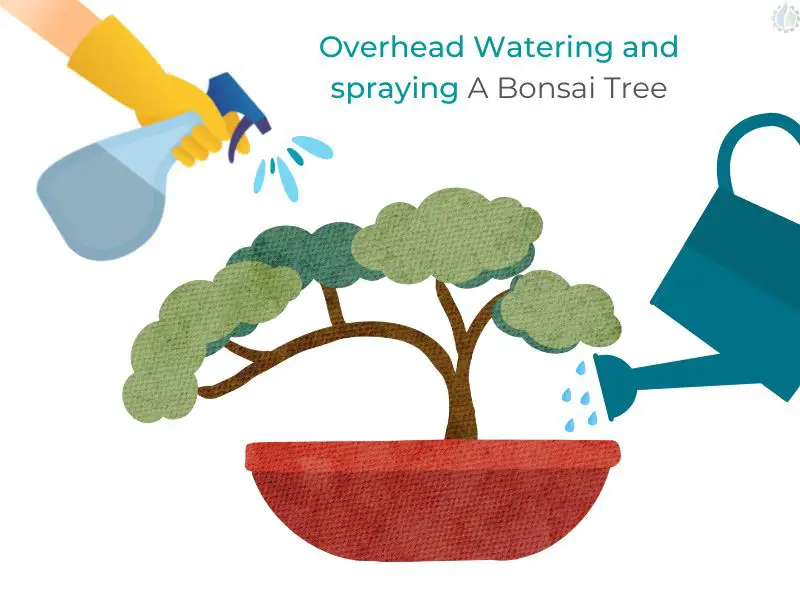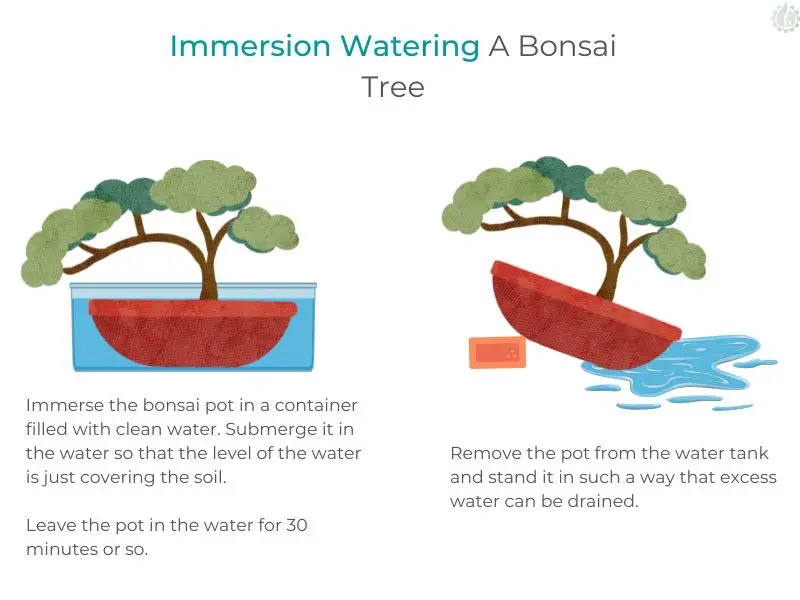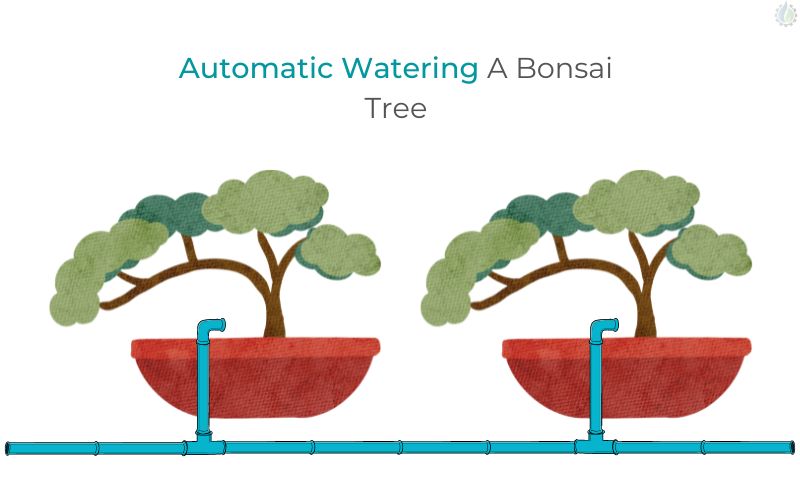Bonsai beginners are sometimes so anxious about their bonsai tree not receiving enough water that they end up over-watering the bonsai.
Interestingly, most bonsai are lost to over-watering rather than drought.
Only a few bonsai trees can grow in permanently saturated soil, and others prefer dry roots during certain periods of the growing season. However, most require that the soil not become completely dry between watering sessions.

You can determine whether your trees need watering by gently scratching away the soil’s surface to see how wet it is underneath. When it’s just damp, water the soil. When it’s wet, do not water the soil.
You should water the soil immediately if it is bone dry (use the immersion technique mentioned further down in the article).
Should I water my bonsai everyday?
Watering a bonsai daily depends on the species of the bonsai tree. For example, jade plant bonsai can survive for several weeks without water and if watered every day, its roots will rot. On the other hand, Fukien tea bonsai needs plenty of water and can be watered everyday.
Types of water and water quality for bonsai tree
Using rainwater for watering bonsai tree
Rainwater is perfectly suitable for most plants. There are a few salts in it and it is very soft.
The ideal way of collecting rainwater is to take it from guttering.
Several builders’ merchants sell devices that attach to downpipes to control water flow. The water can be fed into a water butt.
At the beginning of a downpour, the water contains a large quantity of harmful substances and is fairly acidic. Therefore, water shouldn’t be fed into the butt until it has rained for some time and most of the airborne harmful substances have fallen to earth.
Few things you need to keep in mind for using rainwater in bonsai culture:
- The bonsai trees should be fed extra lime if they are only supplied with rainwater.
- Furthermore, there is also a risk of water contamination by fungi and air-borne spores. This contaminated water can damage the bonsai tree.
- In case you are planning to store the rainwater, make sure you make proper arrangements of sealing the water containers or tanks.
Using tap water for watering bonsai tree
The quality of tap water varies widely from region to region. Depending on how it is obtained, it can be relatively hard or soft.
Water supplied from dammed river valleys can be very soft. On the other hand, river water filtered along river banks often contains high levels of mineral salts such as calcium, making it very hard.
Tap water in some areas is ‘hard’ which is not suitable for calcifuge plant species (plants that do not tolerate alkaline conditions).
If you live in such areas, then use acidic soil or use a soil acidifier to counter hard water. Also check how to make bonsai soil mix at home to make a soil suited for your bonsai.
Sometimes, because of hard water, the roots of a bonsai tree will get coated with a layer of lime. These are not harmful and can be easily scraped off.
Water from the tap contains all kinds of chemicals added to ‘purify’ it. In low concentrations, none of these chemicals are particularly harmful to plants. However, occasional higher concentration of chlorine can cause some issues in plants.
- You can evaporate chlorine from water by allowing it to stand for a few hours before using. This will also bring the water to room temperature.
- Do not use water that has been artificially ‘softened’. The sodium in water softeners is even more harmful than calcium.
- If you add ice-cold water to a sun-warmed pot, the roots will be shocked and will suffer temporary damage. Conversely, water that is a few degrees cold refreshes and cools the roots in hot weather.
- Water the bonsai tree at either the beginning of the day or at the end of the day, at a time when the roots are not so heated.
- You may use a fine spray attachment on a hose if you have a large collection of bonsai. You should always let some water run for a few minutes before using a hose that has been lying in the sun. If you let the hose sit in the sun for very long, the water will become very hot.
Can I water my bonsai with tap water?
Yes. Tap water can be used to water your bonsai trees. Generally, tap water has a varying level of hardness. As long as the hardness of tap water is not more than 12-15 degrees and the lime content of water is low, it should be good enough for irrigating the bonsai tree.
Using distilled water for bonsai tree
Is distilled water good for bonsai?
Using distilled water alone for your bonsai can be harmful to the tree in the long run. Distilled water or de-ionized water has a very small “buffering capacity” (water’s ability to keep the pH level of the soil stable). Hence, using only distilled water will lead to a drastic change in the pH of the soil in a short time. Distilled water, however, can be used effectively for reducing mineral content by mixing it with hard water. You can reduce the salt content by half by mixing equal portions of distilled and hard water.
Using well water for bonsai tree
There are some people who have access to groundwater from wells. Before using such water to irrigate bonsai trees, it should be thoroughly examined. In many cases, groundwater has a high mineral salt content, which damages bonsai trees.
What water is best for bonsai?
The best water for bonsai trees is rainwater. As compared to tap water, distilled water or well water, it is much softer and doesn’t drastically affect the pH of the bonsai soil. However, when you are using only rain water to water your bonsai, apply some supplementary lime to the soil as well. Or, you can also supplement with regular hard tap water at regular intervals.
How often should you water your bonsai tree?
Bonsai trees with waxy, shiny leaves are adapted to conserve water, which means they do not need to be watered as often. On the other hand, bonsai trees with thin, smooth leaves tend to lose moisture more quickly through evaporation, so they require more frequent watering. The frequency of watering a bonsai also depends on external factors such as soil, air, temperature and humidity.
Dry bonsai soil conditions
It is never a good idea to wait for the bonsai soil to become bone dry and then water the tree.
Even a short period of complete root drying will result in the dying of finer roots and consequently the tree becoming weak. Even worse, some tree species which prefer damp conditions can even die when subjected to drought for even a day.
Additionally, bone dry soils are difficult to re-wet. When watered, the water slips through the space between the inner side of the bonsai pot and the soil. The water penetration might give an illusion of soil being moistened, however it is highly likely that the central part of the soil will still remain dry.

You can try and save a broad leaved bonsai tree suffering from dry soil by trimming the leaves. This can help in preserving whatever water is left which the tree could have lost to evaporation.
Wet bonsai soil conditions
As opposed to dry soil conditions, excessively wet soil can be equally bad if not worse.
Waterlogged soil literally chokes the roots. The roots will start rotting and ironically even in the presence of lot of water in the soil, the tree will not be able to get enough water and nutrients.
Ideally, the bonsai soil should be kept just moist or in some cases just a little dry to the touch. The specific timings and the need of water for different plants varies depending on the species.
Do bonsai trees need a lot of water?
The watering requirements of a bonsai tree depends on the type of bonsai tree. However, there are few conditions where irrespective of the bonsai tree species, your bonsai will need a lot of water. Some of these conditions can be:
- If the plant has lot of large leaves.
- If the bonsai tree is not repotted for a long time.
- If the bonsai container is too small for the tree.
- If the bonsai pot is extremely shallow and the surface area of the soil is large.
- If the environment is too hot. For instance, peak season of summer.
Methods of watering bonsai tree
Bonsai tree watering techniques can be done primarily in three ways : Overhead watering and spraying, Immersion watering and Automatic watering.
1. Overhead watering and spraying a bonsai tree

This technique can be used for both indoor and outdoor bonsai trees. However, it is mostly used for outdoor bonsai trees.
Use a watering can or a hose (attached with fine rose spray) to water the bonsai soil. Keep watering till you see the water covering the soil and touches the rim of the bonsai pot.
Wait for the water to soak into the soil. Repeat this process till you see water draining from the drainage holes.
Spraying the leaves with a spray bottle can also be done. However, this spraying can only be done on specific bonsai species as spraying the foliage sometimes damages the trees in full sun. Spraying can also help in removal of spots which are cause by foliar application of bonsai fertilizers.
The soil surface should be watered thoroughly. It is common to neglect the area behind the trunk, causing the roots as well as the branches directly above them to weaken.
Make sure you do not water your bonsai the same amount every day. Each pot should be examined every day and the watering adjusted as needed.
2. Immersion Watering A Bonsai Tree

As opposed to overhead watering, this technique is mostly used for indoor bonsai trees.
The immersion technique is used specially when you notice that the bonsai soil is getting dry quicker than usual.
The quick drying of the soil can be attributed to many reasons.
- May be the roots have become pot bound and there is not enough space for the water in the pot.
- Also, sometimes the soil is mounded on the bonsai pot. This leads to water running off from the sides of the pot rather than being soaked in the soil.
- The soil in imported indoor bonsai is usually dense, clay-like, which may be ideal for growing bonsai in the nursery, but not for long-term growth in home settings. Compacted soil has a difficult time absorbing water.
When the roots are pot bound, submerging the pot in water is not a solution. Repotting the bonsai tree in a bigger pot will help in the longer run.
Immerse the bonsai pot in a container filled with clean water. Submerge it in the water so that the level of the water is just covering the soil.
As the water replaces the air in the soil, you should see bubbles rising from the soil. It is possible that the soil is very compacted if there are no bubbles.
Keep the pot in water for almost half an hour or till the bubbles have stopped emerging. Remove excess water by tilting the bonsai container.
3. Automatic watering a Bonsai Tree

Automatic watering systems are primarily used in case when you are unavailable for some time or you have a huge collection of bonsai which will require a lot of time to water when done manually.
A variety of automatic watering systems are used by commercial nurseries, ranging from overhead sprays to drip feeds.
In automatic watering systems, a constant amount of water is supplied to each plant, but they do not take into account the individual watering requirements of each plant.
While they are away from home, some bonsai growers use timed low-level sprays or drip feeds, but they must plan very carefully.

An alternative solution to taking care of your bonsai water needs in your absence can be that you can bury the bonsai pot in a moist and shady corner of your garden.
Bury the pot in such a way that the bonsai soil is almost half an inch deep in the ground.
This can take care of your bonsai for 1-2 weeks.
Also, some nurseries provide a service of taking care of your bonsai when you are away. Check with your local nursery if they can do that.

